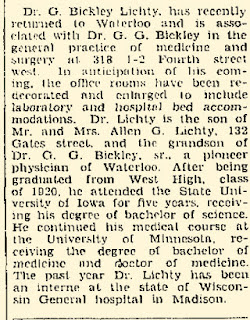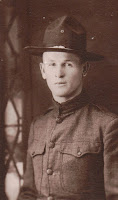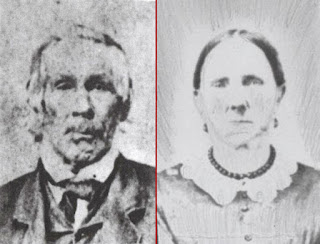
I'm always interested in learning about the families my family married into. A case in point is Mary Madora "Dora" Smith Lichty, who married Benjamin Franklin Lichty of Somerset County, Pennsylvania.
The Lichty family hailed from Switzerland in the early 1700s. The Lichty's settled in Somerset County, Pennsylvania and many remained there even as factions of the family broke off and moved to Iowa.
Joseph Jacob Lichty (1758-1847) was also born in Switzerland. He married Frances Veronica Forney (1773-1844). They would both remain in Somerset County. Several of their 14 children moved to Black Hawk County and would become scions of the city of Waterloo, taking leadership roles, as captains of industry, doctors, lawyers, politicians, and farmers with vast amounts of property. They were incredibly industrious, to say the least, and very integral to the history of Waterloo.
Abram had a son, Elias, who was the father of "my" Lichty (B.F. Lichty). Abram died in Black Hawk County in 1882, his wife Elizabeth Meyers, having died in Somerset County in 1864.
Abram's brother, Jacob, had nine children. Included in that batch of kids was Lewis Lichty, former early mayor of Waterloo. I'll cover him in a different post. Others moved on to Creston, Iowa, where they too, would be movers and shakers in the community.
Abram's brother, Daniel, married Sarah Cobaugh. They in turn had three children, including
George Cobaugh Lichty, who then with wife Sarah Casebeer had nine children, one of whom was
Allen George. Allen and his wife,
Josie Bickley, daughter of Dr. G G Bickley (talk about a bunch of doctors in that bunch - the family was very prominent), had three kids and the baby was
Gabriel Bickley Lichty, the subject of this post.
I'm always interested in people who are given all of life's advantages and through dumb luck, bad decisions, or any combination of both, end up losing it all. G. Bickley Lichty is a case in point. There would be no redemption for Bickley, who seemed to keep making the same mistakes.
Bickley was born on 07 Mar 1903 in Black Hawk County. He was a stellar student and was named class valedictorian of his Class of 1920 of West High School in Waterloo. The athletic Bickley, who was a excellent pole vaulter, would graduate and go on to the University of Iowa, where he would receive a bachelor of science degree. From there, he went on to the University of Minnesota Medical School and the took an internship in Madison, Wisconsin at the Wisconsin General Hospital.
The only blip on the radar had occurred when he was 18 and had purportedly been driving on the wrong side of the road at a high rate of speed in his father's car, when it struck 18-year-old Alfred Miller on his motorcycle, destroying the motorcycle and severely injuring Alfred. Allen and Bickley were sued for $10,000 by Miller and his mother. The outcome of that suit is not known.

Things were all set up for him and upon his return to Waterloo, he joined the practice of his uncle,
second generation doctor GG Bickely, Jr., in January of 1928. The Bickley practice was well-established. Bickley Lichty enjoyed some renown and was often called upon to testify on medical matters in the courts.
Finally established, Bickley married Miss Hilda Faye Ellis, daughter of Mr & Mrs WN Ellis of 1210 7th St West in Clarksville, Iowa on Friday, August 30, 1929.
His career hummed along, but his health was precarious. Bickley was diabetic and his eyesight began to fail. In 1948, his second wife, Pearl F Metcalf, whom he's married in 1939, divorced him. In 1949, the dark turn of events began that would shape the remainder of Bickley's life.
On November 17, 1949, Bickley was arrested for "attempting to produce an
abortion." The County Attorney, Blair Wood, made it his business to pursue the matter to its conclusion. When four witnesses disappeared, he spent plenty of man-hours tracking his witnesses down and placing two of them in custody as material witnesses, of the other two, one was hunted to ground in Washington DC and one in Chicago. Though the case was delayed twice, it was finally adjudicated with a surprise change of plea to guilty. Bickley acknowledged he had performed countless abortions in the past. Despite Bickley's growing blindness and health issues related to diabetes, the judge gave him the maximum, a five-year sentence and $1,000 fine.
Bickley was out of jail on appeal and then entered the Iowa State Penitentiary at Fort Madison in
June of 1950. He would serve 13 months before he was released on parole. He was by now nearly completely blind and no longer had his medical license. The authorities were still watching him.
On January 3, 1954, a married couple from Wisconsin entered the home of Dr. Lichty and upon their departure, they were grabbed and interrogated by authorities who then, with search warrant, entered Lichty's home and arrested him, confiscating the $500 the couple had paid him for an abortion and the doctor's medical instruments. Later, the wife was put into a local hospital and the husband was held by police as a material witness. Authorities found that Dr Lichty was using the kitchen table for procedures and we can surmise this was not the only illegal surgical procedure he'd done.
He again pleaded guilty and was out on appeal under bond when he died in a Waterloo hospital from complications of diabetes and pneumonia. He was in a diabetic coma for several days prior to his death. Had he survived, he most likely would have begun serving his second 5-year term in prison and had to pay, this time, a $500 fine. His body was cremated in Cedar Rapids and a small service was held.
WEST HIGH ATHLETES WILL FOREGO FUDGE N EVERYTHING TO GET IN SHAPE FOR TRACK EVENTS, Waterloo Evening Courier; Friday, March 19, 1920, Waterloo, Iowa
HONOR STUDENTS AT WEST HIGH SELECTED BY FACULTY TODAY,Waterloo Evening Courier; Wednesday, April 28, 1920, Waterloo, Iowa
$10,00 BALM ASKED FOR BOY IN AUTO SUIT, Waterloo Evening Courier;Thursday, April 27, 1922, Waterloo, Iowa
Dr G BICKLEY LICHTY, Waterloo Evening Courier; Friday, January 13, 1928, Waterloo, Iowa
DOCTORS CALLED AS WITNESSES IN PERMIT HEARING, Waterloo Evening Courier;
Friday, March 9, 1928, Waterloo, Iowa
BICKLEY REUNION TO BE AT BYRNES PARK ON AUG 15, Waterloo Evening Courier;
Thursday, July 26, 1928, Waterloo, Iowa
MISS HILDA ELLIS BECOMES BIRD OF DR BICKLEY LICHTY, Waterloo Evening Courier;
Saturday, August 31, 1929, Waterloo, Iowa
WATERLOO MAN IS ARRESTED ON ABORTION COUNT, Mason City Globe Gazette; Thursday, November 17, 1949, Mason City, Iowa
LICHTY ARRAIGNMENT POSTPONED TO FEB 1, Waterloo Daily Courier; Tuesday, December 20, 1949, Waterloo, Iowa
PLEADS INNOCENT TO CHARGE OF ABORTION, Fairfield Daily Ledger; Wednesday, February 1, 1950, Fairfield, Iowa
SEARCH CONTINUES FOR WITNESSES IN DR LICHTY CASE, Cedar Rapids Gazette;
Monday, March 27, 1950, Cedar Rapids, Iowa
WATERLOO DOCTOR ON TRIAL IN MAY, Mason City Globe Gazette; Monday, April 17, 1950, Mason City, Iowa
DOCTOR GETS FIVE YEARS FOR ABORTION, Ottumwa Daily Courier; Thursday, April 27, 1950, Ottumwa, Iowa
STARTS FIVE YEAR TERM, Mount Pleasant Mt Pleasant News; Monday, June 5, 1950, Mount Pleasant, Iowa
DR LICHTY IS PAROLED FROM FT MADISON, Waterloo Daily Courier; Monday, July 23, 1951, Waterloo, Iowa
LICHTY HELD ON ABORTION CHARGE, Waterloo Daily Courier; Monday, January 4, 1954, Waterloo, Iowa
GABRIEL LICHTY, FORMER WATERLOO DOCTOR, DIES, Cedar Rapids Gazette; Sunday, April 25, 1954, Cedar Rapids, Iowa
PNEUMONIA FATAL TO DR LICHTY, Waterloo Daily Courier; Sunday, April 25, 1954, Waterloo, Iowa
NOTICE OF APPOINTMENT OF ADMINISTRATORS, Waterloo Daily Courier; Wednesday, May 19, 1954, Waterloo, Iowa
 What we work on, in our genealogical research, is discovering what the lives and loves of our ancestors were like in whatever small way we can, without a big book of family stories to read from. Filling in those blanks has brought me great pleasure this past three years. I've taken trips of exploration, interviewed distant relatives, researched parts of family I never knew I had, and met with others in my own far-flung family who share my interests in-person from time-to-time (shout out to my cousin in Clarksville!)
What we work on, in our genealogical research, is discovering what the lives and loves of our ancestors were like in whatever small way we can, without a big book of family stories to read from. Filling in those blanks has brought me great pleasure this past three years. I've taken trips of exploration, interviewed distant relatives, researched parts of family I never knew I had, and met with others in my own far-flung family who share my interests in-person from time-to-time (shout out to my cousin in Clarksville!)













































